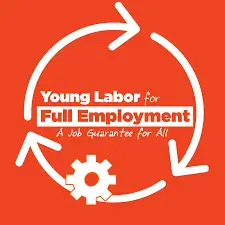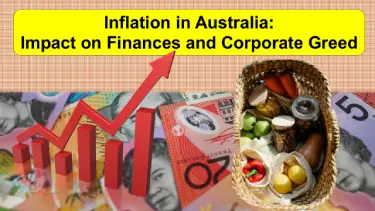Description
Explore how corporate greed drives inflation in Australia, why government payments lag, and the impact on daily expenses like groceries and utilities.
Introduction

Inflation in Australia is no longer just a topic for economists—it’s something that Australians feel every time they shop for groceries, pay utility bills, or manage their rent. However, a deeper look reveals that inflation is not just the result of supply and demand fluctuations; it’s also driven by corporate greed and massive profit-taking.
Coupled with government support payments that are well below the poverty line, these factors are worsening the financial stress on everyday Australians. This article explores how these elements contribute to inflation and why the federal government, despite having sovereignty over its currency, chooses policies that keep unemployment high and people in poverty.
1. Inflation: Inflation, driven by corporate greed and inadequate government support, is eroding the purchasing power of Australians, making it increasingly difficult to keep the same standard of living.
2. Prices: As prices continue to rise due to profit-driven inflation, more Australians are struggling to keep up with basic expenses, leading to financial stress and difficult choices, while government payments do not provide adequate relief.
3. Corporate greed: By understanding how corporate greed and government policies contribute to inflation and poverty, you can better navigate these challenges and advocate for change.
The Current State of Inflation in Australia
Definition of Inflation
Inflation refers to the general increase in prices over time, which reduces the purchasing power of money. In Australia, inflation is measured by the Consumer Price Index (CPI), which tracks the cost of a basket of goods and services. When inflation rises, each dollar buys fewer goods, which can have a profound effect on household budgets.
Recent Trends in Australian Inflation
Inflation in Australia has been on an upward trajectory due to a range of factors, including supply chain disruptions, increased demand post-pandemic, and geopolitical tensions affecting global markets. In 2024, Australia experienced one of its highest inflation rates in decades, reaching levels not seen since the early 1990s. However, a less discussed but significant driver of this inflation is corporate greed, where companies raise prices far beyond what is necessary to cover costs, aiming to maximize profits at the expense of consumers.
Historical Context
While inflation has fluctuated over the years, the current spike is particularly concerning because it is driven by both global and domestic factors, including aggressive profit-seeking behaviour by corporations. Historically, Australia has enjoyed stable inflation rates, but recent economic shocks, compounded by corporate strategies to boost profits, have led to rapid price increases across various sectors, affecting the cost of living for millions of Australians.
Impact on Daily Expenses
Rising Grocery Prices
One of the most immediate and noticeable effects of inflation is the rising cost of groceries. From fruits and vegetables to dairy products and meat, the price of food has skyrocketed. This section explores how these increases are affecting Australian households.
– Food Inflation Statistics: According to recent reports, food prices in Australia have increased by over 10% in the past year. Staples like bread, milk, and eggs have seen some of the sharpest rises. Much of this increase can be attributed to corporate pricing strategies that prioritize profit margins over consumer welfare.
– Corporate Greed and Price Gouging: Large corporations often take advantage of inflationary periods to increase prices more than necessary, blaming external factors like supply chain issues while pocketing higher profits. This practice, known as price gouging, is a significant driver of current inflation in Australia.
– Consumer Behaviour Changes: As grocery bills rise, Australians are altering their shopping habits. Many are turning to discount stores, buying in bulk, or opting for generic brands to stretch their budgets.
– Impact on Low-Income Families: Low-income households are disproportionately affected by food inflation. With a larger part of their income devoted to necessities, these families are facing difficult choices, such as cutting back on healthier foods or relying on food banks.
Utilities and Energy Costs
Inflation doesn’t just stop at the supermarket—it also affects the cost of keeping the lights on and the water running. Rising utility prices are a significant concern for many Australians, especially as energy costs continue to climb.
– Electricity and Gas Price Hikes: Energy prices have risen sharply due to increased demand and supply constraints. However, a huge part of these increases is due to energy companies raising prices to boost their profit margins, contributing further to inflation. Households see their electricity bills soar, with some states experiencing double-digit percentage increases.
– Water Costs: Water prices are also on the rise, driven by infrastructure costs and environmental factors. These increases are adding to the financial burden on households already stretched thin by other expenses.
– Coping Mechanisms: Australians are employing various strategies to manage rising utility costs, from installing energy-efficient appliances to reducing consumption. Government assistance programs, such as rebates for low-income households, are also playing a crucial role in helping Australians cope, although these are often insufficient to fully counteract the effects of inflation.
Housing and Rent Pressures
The housing market has been significantly affected by inflation, with both renters and homeowners feeling the squeeze. Rising costs in this sector are leading to increased financial stress, particularly for younger Australians.
– Rent Increases: Rent prices have surged in many parts of Australia, driven by high demand and limited supply. However, the role of corporate landlords and property management companies in driving up rents to increase profits cannot be overlooked. This is particularly problematic in major cities like Sydney and Melbourne, where rental markets are already competitive.
– Mortgage Rate Pressures: Inflation has led to higher interest rates, which in turn, increases mortgage payments. This is making home ownership less affordable, especially for first-time buyers. Banks and financial institutions often raise rates in response to inflation, not just to manage risk but also to keep or increase their profit margins.
– Impact on Young Australians: The younger generation is facing a double challenge—rising rents and the increasing difficulty of entering the housing market. Many are being forced to delay home ownership, opting instead to stay in the rental market or move in with family to save money.
Broader Economic Implications
Wages vs. Inflation
One of the most concerning aspects of inflation is that wages are not keeping pace with rising prices. This wage stagnation is reducing the real income of workers, making it harder for Australians to keep their standard of living.
– Wage Stagnation Data: Despite a tight labor market, wage growth in Australia has still been sluggish. This disconnect between wages and inflation is leading to a decrease in buying power for many workers. Meanwhile, corporate profits continue to soar, highlighting the growing income inequality.
– Workforce Impact: The mismatch between wage growth and inflation is causing dissatisfaction among workers. This has implications for job satisfaction, worker productivity, and even the broader economy, as people cut back on spending. The gap between what workers earn and what they need to spend on essentials is widening, leading to increased financial stress.
Government Support Payments and Poverty
Government support payments, such as unemployment benefits and pension payments, are designed to provide a safety net for those in need. However, in Australia, these payments are significantly below the poverty line, leaving many Australians struggling to make ends meet.
– Inadequacy of Government Payments: Current government support payments are insufficient to cover the basic cost of living, especially in an inflationary environment. As prices rise, these payments become even less adequate, pushing more people into poverty.
– High Unemployment and Poverty by Design: Despite having sovereignty over its currency, allowing it to spend without revenue constraints, the Australian federal government supports policies that keep unemployment high and people in poverty. This is partly due to neoliberal economic policies that prioritize budget surpluses and inflation control over full employment and social welfare.
– Why the Government Chooses These Policies: The government’s focus on keeping low inflation through high unemployment is rooted in a belief that low unemployment would lead to wage inflation and further price increases. However, this approach disproportionately affects the most vulnerable in society, keeping many in a state of financial insecurity. The government’s reluctance to raise support payments to above the poverty line reflects a broader commitment to neoliberal principles that favour market efficiency over social welfare.
Why NAIRU Falls Short and the Case for a Federal Job Guarantee
 The Non-Accelerating Inflation Rate of Unemployment (NAIRU) is a concept used by economists to argue that there is a specific level of unemployment below which inflation will start to rise. This approach implies that keeping some level of unemployment is necessary to control inflation.
The Non-Accelerating Inflation Rate of Unemployment (NAIRU) is a concept used by economists to argue that there is a specific level of unemployment below which inflation will start to rise. This approach implies that keeping some level of unemployment is necessary to control inflation.
However, this method is deeply flawed as it unnecessarily sacrifices the well-being of workers, particularly the most vulnerable, by maintaining a pool of unemployed individuals to regulate the economy. A more effective and humane approach to managing inflation is through a federal job guarantee. By ensuring that everyone who wants to work can find a job, a job guarantee program would not only provide full employment but also stabilize the economy by adjusting public sector employment in response to economic fluctuations.
This approach directly addresses the root causes of inflation without resorting to policies that keep people in poverty and unemployment. It fosters economic security and reduces the social costs associated with high unemployment, making it a far superior tool for regulating inflation and promoting overall economic stability.
Coping Strategies and Consumer Advice
Financial Planning Tips
In times of high inflation, effective financial planning becomes essential. This section gives actionable advice on how Australians can manage their finances to mitigate the impact of rising costs.
– Budgeting: Creating and sticking to a budget is more important than ever. By tracking income and expenses, Australians can find areas where they can cut back and save.
– Saving on Groceries and Utilities: Simple changes, such as buying in bulk, shopping during sales, and reducing energy consumption, can lead to significant savings over time.
– Navigating the Housing Market: For those looking to buy or rent,
understanding the market and timing purchases carefully can help avoid overpaying. Additionally, seeking out government grants and first-time homebuyer programs can provide financial relief.
Community and Government Resources
There are numerous resources available to help Australians cope with inflation. This section highlights some of the most useful programs and services.
– Aid Programs: From energy rebates to food vouchers, various government programs are available to support those struggling with rising costs.
– Educational Resources: Financial literacy programs can equip Australians with the knowledge they need to manage their finances effectively in an inflationary environment.
The Future Outlook
Economic Predictions
While predicting the exact course of inflation is challenging, experts agree that certain trends are likely to persist. This section explores these predictions and what they mean for the average Australian household.
– Inflation Forecasts: Many economists predict that inflation will remain elevated for the near future due to ongoing global and domestic pressures, including corporate profit-seeking behaviour. However, there is hope that it will stabilize over time as supply chains recover and demand normalizes.
– Long-Term Strategies: While not all households have the means to invest in inflation-protected assets or maintain a diversified portfolio, there are still practical steps that can be taken. Low-income workers can focus on reducing debt, building small emergency savings, and consistently seeking out cost-saving opportunities to mitigate the effects of ongoing inflation. Accessing community resources and financial counselling can also provide valuable support during these challenging times.
Conclusion
Inflation is undoubtedly reshaping everyday life in Australia, with rising costs affecting everything from groceries to housing. The situation is worsened by corporate greed driving up prices and government policies that keep support payments below the poverty line. While the challenges are significant, understanding the dynamics at play and adopting smart financial strategies can help Australians navigate this difficult period.
Reader Interaction
What strategies are you using to manage rising costs in your daily life? Share your experiences and tips in the comments below.
Call to Action
Stay informed and protect your finances by subscribing to our newsletter for the latest tips and updates on managing inflation.
Social Sharing
If you found this article helpful, share it with your friends and family on social media to spread awareness and help others manage the impact of inflation.

